Fire Safety in Care Homes: Regulation, Prevention & What to Do
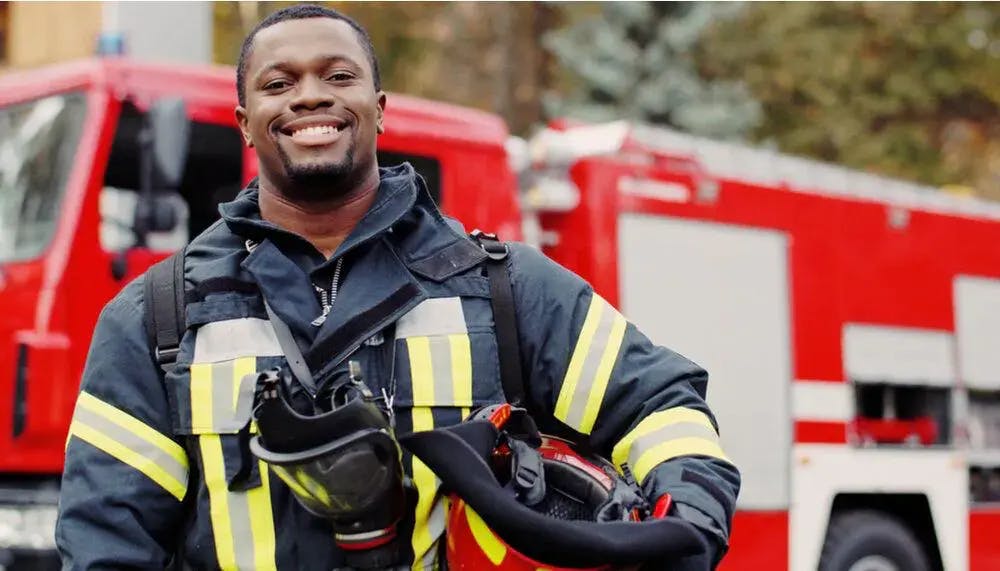
Estimated Reading Time: 12 minutes
The safety of residents in a care home is incredibly important. One of the ways a care home can keep its residents safe is by putting the right regulations and procedures in place regarding fire safety.
In this article, we’ve explained everything you need to know about fire safety in care homes, including why it’s important, the relevant acts and regulations, risk assessments, care home staff responsibilities, what to do in the event of a fire and how to prevent fires from occurring in a care home.
Kickstart your care search
Find the best care homes in your area through Lottie.
In this article:
- The importance of fire safety in care homes
- Acts and regulations relating to fire safety
- Government fire safety guidance document
- Fire risk assessments
- Fire safety responsibilities and compliance
- Equipment for fire safety
- What to do in the event of a fire
- Fire risks and prevention
- How does the Care Quality Commission regulate fire safety in care homes?
The Importance of Fire Safety In Care Homes
When a fire starts in a building, it can spread very quickly, especially if the building is old.
Fires can lead to health complications, property damage and in some cases, a loss of life, which is why fire safety is so important.
Having the right fire safety procedures in place ensures that everyone leaves the building safely and calmly and in the quickest time possible. Without a procedure, people are likely to move in all directions, often while in a panicked state.
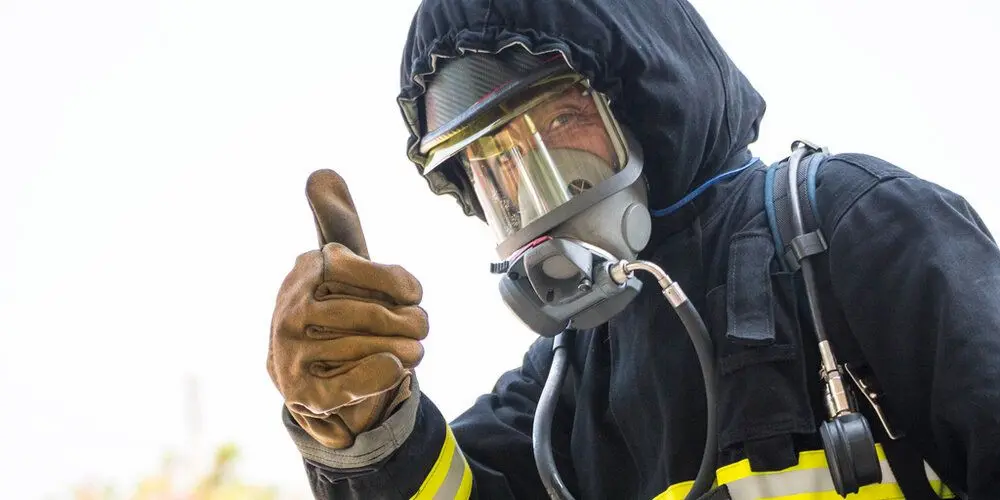
Fire safety is even more important in care homes, where many residents may be hard of hearing, have impaired vision or limited mobility.
By not having a fire safety procedure in a care home, you’re risking the lives of often vulnerable older adults. Fire safety is also a law in the Fire Safety Order and the Care Home Regulations Act respectively, which is regulated by the Care Quality Commission (CQC). If care home groups fail to meet these legal obligations, they can face a large fine or even go to prison.
The Health and Social Care Act (2008)
The Health and Social Care Act (2008) established the Care Quality Commission (CQC) as the independent regulator of health and social care in England. The Care Home Regulations Act (2001) has now been replaced by this more recent act.
In relation to fire safety, care homes are required to meet the legislation set out in the Regulatory Reform Fire Safety Order (2005).
The Care Home Regulations Act (2001)
The Care Home Regulations Act (2001) explains fire safety regulations for care homes, including how care homes should approach fire safety and how complaints about fire safety in a care home are handled. This act was amended in 2003 and was repealed in 2008, having been replaced by the Health and Social Care Act (2008).
Under the Care Home Regulations Act, care home managers and owners needed to look at several key responsibilities they had towards care home residents, including:
- Consulting fire authorities for advice on the best fire safety strategy for their care home
- Making sure all necessary precautions were in place to reduce the risk of fires
- Putting policies in place that allowed for quick fire detection, containment and extinguishment
- Ensuring fire safety equipment was regularly checked and maintained
- Appointing a properly trained fire marshall for the care home
- Ensuring all staff knew how to react in the event of a fire
- Organising regular fire drills and evacuation practice
- Keeping an up-to-date fire safety log. This should have included details of all training, emergency evacuation practices and any incidents that took place in the home
The Regulatory Reform Fire Safety Order (2005)
The Regulatory Reform (Fire Safety) Order 2005 covers fire safety in care homes, including:
- How to carry out fire assessments
- How to detect fires
- How to reduce the risk of fire
- How to ensure staff are properly trained
- Who is responsible for fire safety within the care home (such as the home’s manager)
The care provider is the main party responsible for anything relating to fire safety in a care home.
Local fire authorities can regularly inspect care homes to ensure they’re fully compliant with the regulations explained in these laws. They may carry out an inspection as part of a routine check or after a fire has occurred.
If a care home has breached any regulations, it may be given a fine, or those held accountable could be imprisoned, along with having their licence to operate a care home removed.
Government Fire Safety Guidance Document
There’s plenty of fire safety guidance available from numerous sources. For example, the UK government’s fire safety guidance can be found in a 150-page document that outlines fire safety strategies for care homes in line with the National Fire Safety Standards.
Government guidance is supported by guidance from the National Association for Safety and Health in Care Services (NASHiCS), in association with the Chief Fire Officers’ Association (CFOA). The London Fire Brigade has also added its findings from a review of 177 care homes.
In the government’s fire safety guidance document, you’ll find advice and guidance about:
- Carrying out fire risk assessments
- Implementing precautions based on the results of an assessment
- Ensuring residents and staff remain safe during a fire
- Giving members of staff the necessary fire training
- Checking fire protection equipment is up to the appropriate standard, along with how to install this fire protection equipment
We’re here to help you find the right care home for you or your loved one. You can request a free list of care homes from our Care Experts, who will then share homes matching your budget, location and type of care needed. You can also search for care through our easy-to-use directory.
Fire Risk Assessments
All fire safety begins with a fire risk assessment and every single care home is required to have a detailed and up-to-date assessment. Fire risk assessments summarise all the potential fire safety risks in a building and the measures the building has in place to prevent or deal with a fire, as well as highlighting areas for improvement.
Fire risk assessments don’t necessarily need to be carried out by an expert, but professional assistance is advised to ensure every fire risk is identified and a plan is put in place that takes them into account. Guidance on fire risk assessments can be found from lots of sources, including the government website.
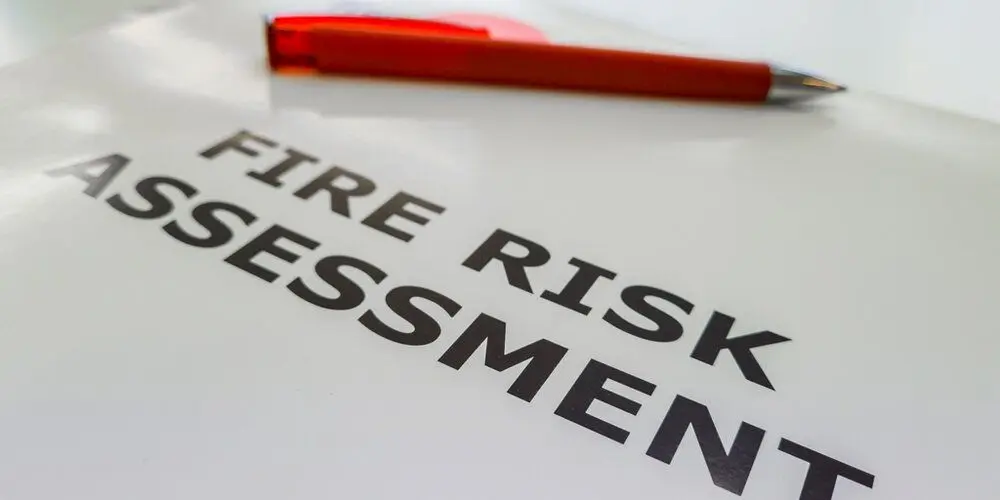
Here’s an example of what a fire risk assessment could include:
- Identifying potential fire hazards
- Determining which care home residents are most at risk if a fire was to occur
- Recording the results of the risk assessment, along with updating fire safety protocols as necessary
Safety considerations
Some of the fire safety precautions care homes can take are:
- Ensuring the home has a simple layout
- Keeping the home clean, tidy and free of clutter
- Making sure everyone in the home has been given training on fire safety regulations and guidelines
Buildings with confusing fire safety routes and objects or furniture causing obstruction can result in dangerous situations.
Fire Safety Responsibilities and Compliance
It’s the role of the ‘Responsible Person’ in a care home to make sure the home is fully compliant with fire safety regulations. This person is often the home's owner or the home’s manager.
The Responsible Person has the following duties:
- Ensuring the safety of all care home residents and staff in fire-related situations
- Appointing a fire warden to manage fire safety
- Arranging staff and resident fire safety training. This should include fire drills, along with regular fire assessments and fire equipment checks
- Ensuring the home has enough fire detection and firefighting equipment, such as fire extinguishers
- Removing any materials from the home that are considered hazardous and could lead to a fire
Staff fire safety training needs to be conducted regularly, ensuring any new staff members receive immediate training. Regular fire drills and evacuation practice should be scheduled, so all members of staff know how to act confidently and calmly in the event of a fire.
Equipment For Fire Safety
Fire alarm systems
There are several types of fire equipment, the main one being fire alarms.
Fire alarms warn of a fire through loud noises and lights. Special alarms are also common in care homes, as these let residents with visual or audio impairments know that there’s a fire.
Care homes should install appropriate fire detection and suppression systems, or fire sprinklers, then create a chart divided into zones by each alarm so staff and firefighters can easily see which alarm has been activated in a fire. Fire alarm systems must be regularly checked and maintained to ensure they’re all in good working order.
Government guidance recommends that each of these zones or compartments should be capable of evacuation in two and a half minutes.
Fire extinguishers
Care homes need to have firefighting equipment on-site. The most common example of this is fire extinguishers. Staff should know how to use this equipment to help limit the spread of fire while waiting for firefighters to arrive.
Fire extinguishers and fire hoses need to meet recommended quality assurance standards and should be placed strategically throughout the home for easy access. They should also be regularly monitored to make sure they still work correctly.
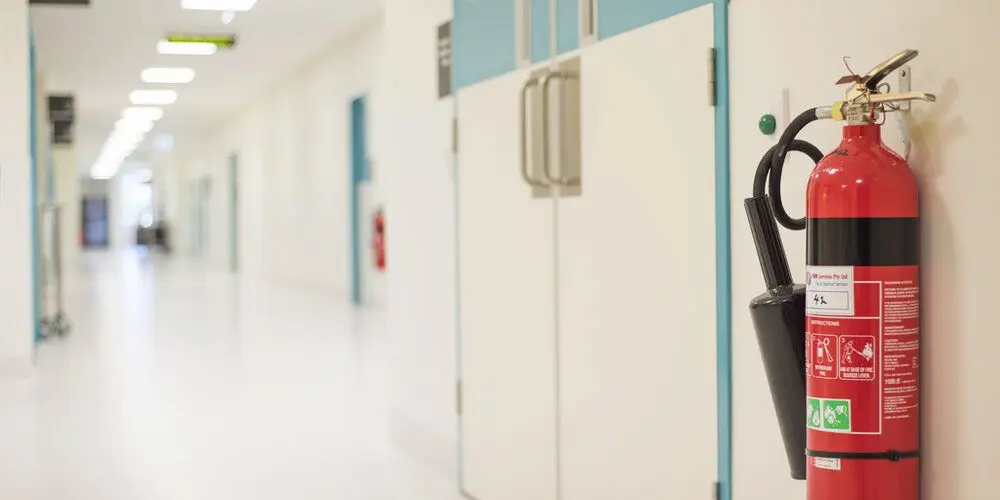
Fire doors
Good quality fire doors are essential for fire safety in care homes. A fire door limits the speed at which fire can spread in a care home, giving staff enough time to evacuate everybody.
Fire doors can be connected to a fire alarm, meaning they’ll automatically close once an alarm sounds.
Fire doors need to close properly, shutting squarely against the door stop. These doors should be checked every month or so, with any necessary repairs being quickly arranged as needed.
What to Do in the Event of a Fire
In the event of a fire, there are typically two types of evacuation procedures to follow:
Simultaneous evacuation - This is where everyone leaves the building immediately upon hearing a fire alarm
Horizontal evacuation - If a fire starts in the building, groups of residents are moved gradually from room to room ahead of the fire, giving staff enough time to reach all residents. This kind of evacuation is aimed at residents who may not be as mobile or are unable to evacuate themselves
If a fire alarm goes off, staff and residents should know to locate and follow the fire marshall’s instructions to leave the building in the quickest and most efficient manner possible.
Evacuation training
All care home staff need evacuation training to know exactly what to do in the event of a fire. There should also be nominated fire marshalls that are known to everyone so residents and staff know who to look for and follow in the event of a fire.
Depending on the type of care home, there may be horizontal evacuation training for staff. For example, a nursing home may have larger numbers of residents with limited mobility.
Staff may also be given training on how to use evacuation aids such as evacuation chairs. These aids help residents with limited mobility be safely evacuated. All evacuation training should be entered into the care home’s fire safety log.
Escape routes
All care homes must have clearly laid out escape routes in the event of a fire. Staff and residents should be taken through evacuation drills so everybody knows where to go if a fire occurs.
Fire escape routes and exits should be free from obstruction at all times, with functional fire safety signs and emergency lighting along all routes.
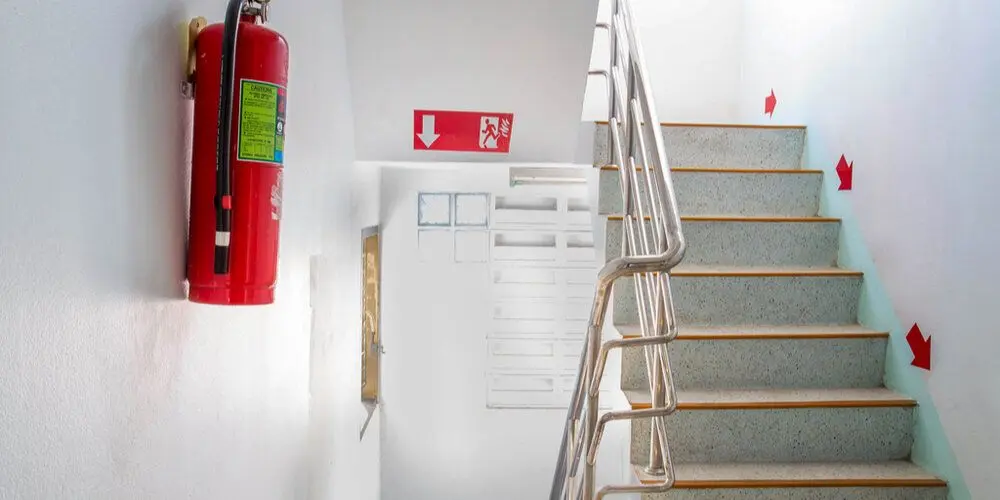
Fire Risks and Prevention
Cooking
One of the most common causes of fires in residential care homes is electrical equipment, including cookers and kitchen appliances. Many fires start in the kitchen, often due to these appliances.
All cooking equipment in a care home should be well-maintained and regularly checked for fire hazards. This equipment should be kept next to flammable materials. Any members of staff that use the kitchen must have been given fire safety training to help them spot potential dangers.
Electrical equipment
Electrical equipment can pose a fire risk if damaged, old or faulty. All electrical equipment in a care home should be regularly checked for wear and tear or any other hazards it may pose, particularly equipment in residents’ bedrooms.
Mobility scooters
Along with causing obstructions to fire escape routes, mobility scooters also present their own fire risk, often while charging. If mobility scooters catch fire, they release smoke and heat which can increase the spread of fire. Fire risk professionals or the fire brigade can give you useful advice on how to safely store mobility scooters to prevent the risk of fire.
Smoking
An unattended cigarette butt in an ashtray, or a cigarette flicked to the floor without being put out can pose serious fire risks in a care home. Smoking is among the other most common causes of fires in care homes.
To prevent smoking-related fire incidents, care homes need to:
- Prevent smoking in bedrooms
- Only allow residents to smoke under supervision
A care home may also encourage any of its residents who are smokers to quit smoking or switch to vapes (e-cigarettes).
How Does The Care Quality Commission Regulate Fire Safety In Care Homes?
The Care Quality Commission (CQC) has begun taking extra interest in fire safety in recent years. In fact, care homes that fail to comply with Fire Service recommendations will find their CQC rating affected as a result. Some care homes have been rated ‘Inadequate’ or have even had their CQC registration removed altogether.
As well as general home inspections, the CQC also now assesses fire safety and how this is managed on a day-to-day basis.
Care homes must ensure that their fire safety policies are updated to prevent dangerous fire-related situations. Elderly and vulnerable peoples’ needs can change over time, meaning that plans might no longer be the best fit in emergency situations.
Lottie matches care seekers with the best care homes for their needs. You can request a free care home shortlist from our Care Experts, who will share homes matching your budget, location and type of care needed. You can also search for care through our easy-to-use directory.



